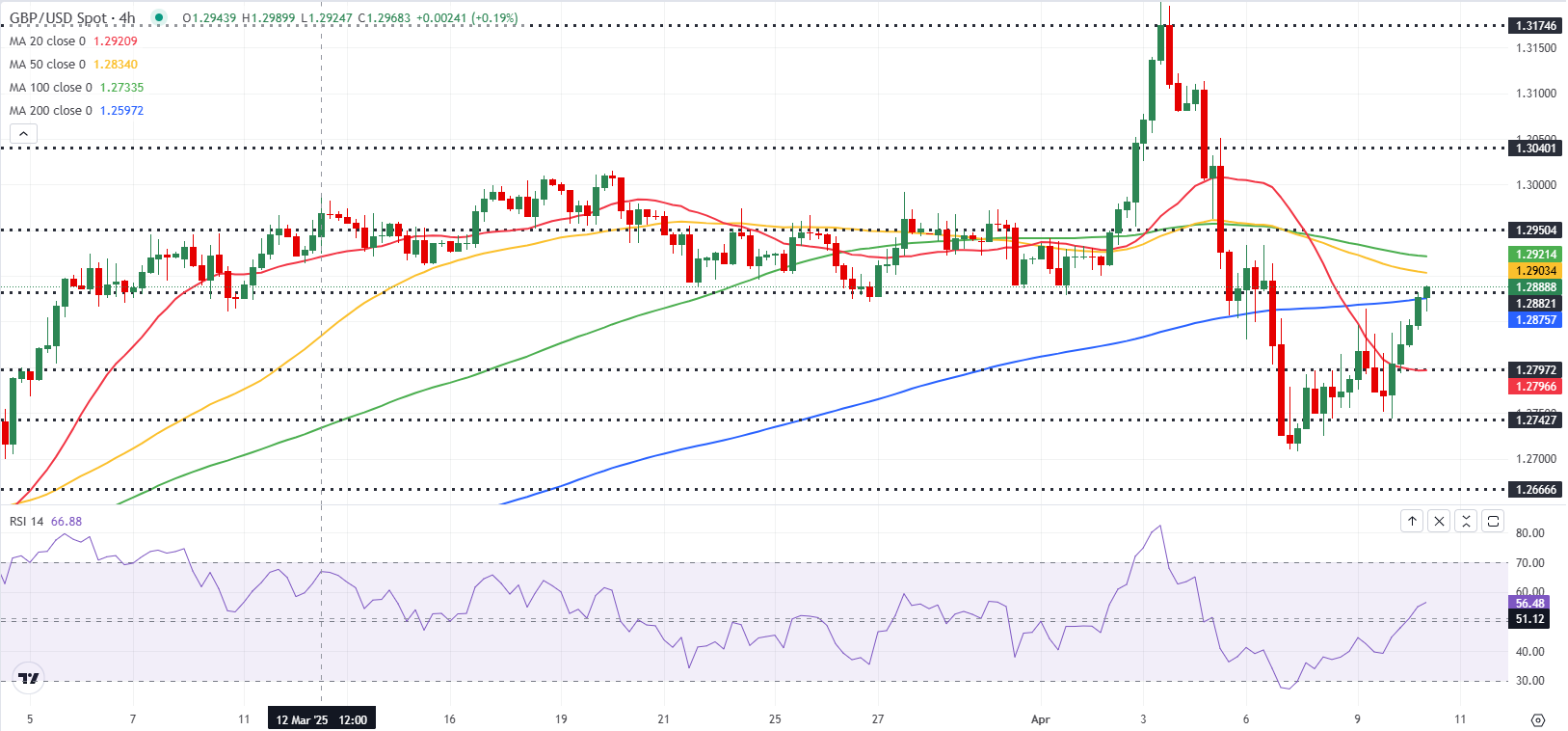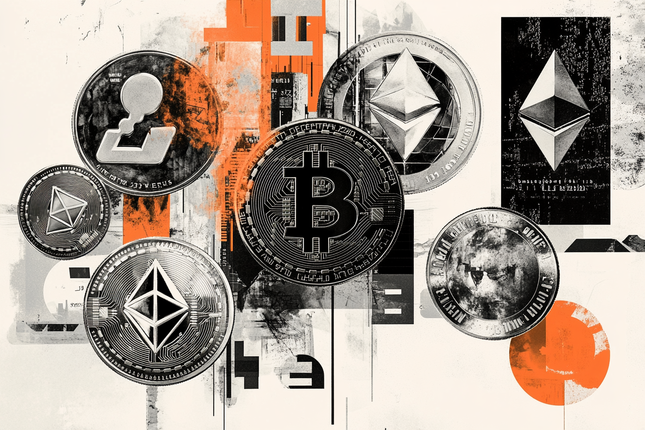- GBP/USD trades above 1.2850 after posting gains for two consecutive days.
- The technical outlook points to a bullish tilt in the near term.
- Annual CPI inflation in the US is forecast to soften to 2.6% in March.
GBP/USD continues to push higher and trades at around 1.2880 in the European session on Thursday after posting gains for two consecutive days. The pair's technical outlook points to a bullish tilt as market focus shifts to March Consumer Price Index (CPI) data from the US.
British Pound PRICE This week
The table below shows the percentage change of British Pound (GBP) against listed major currencies this week. British Pound was the strongest against the US Dollar.
| USD | EUR | GBP | JPY | CAD | AUD | NZD | CHF | |
|---|---|---|---|---|---|---|---|---|
| USD | -0.78% | -0.05% | 0.37% | -1.32% | -1.87% | -1.70% | -1.33% | |
| EUR | 0.78% | 1.04% | 1.81% | 0.08% | -1.16% | -0.30% | 0.07% | |
| GBP | 0.05% | -1.04% | -0.53% | -0.95% | -2.18% | -1.33% | -0.96% | |
| JPY | -0.37% | -1.81% | 0.53% | -1.65% | -1.29% | -0.85% | -1.35% | |
| CAD | 1.32% | -0.08% | 0.95% | 1.65% | -0.89% | -0.39% | -0.28% | |
| AUD | 1.87% | 1.16% | 2.18% | 1.29% | 0.89% | 0.87% | 1.24% | |
| NZD | 1.70% | 0.30% | 1.33% | 0.85% | 0.39% | -0.87% | 0.37% | |
| CHF | 1.33% | -0.07% | 0.96% | 1.35% | 0.28% | -1.24% | -0.37% |
The heat map shows percentage changes of major currencies against each other. The base currency is picked from the left column, while the quote currency is picked from the top row. For example, if you pick the British Pound from the left column and move along the horizontal line to the US Dollar, the percentage change displayed in the box will represent GBP (base)/USD (quote).
The broad-based selling pressure surrounding the US Dollar (USD), following China's decision to retaliate against the US tariffs by ramping up their own tariffs on US goods to 84% from the previously announced 34%, helped GBP/USD push higher in the first half of the day on Wednesday.
During the American trading hours, US President Donald Trump announced that he authorized a 90-day pause on reciprocal and 10% tariffs, effective immediately, but lifted the tariff rate on Chinese imports to 125%. The USD staged a rebound on this development and capped GBP/USD's upside.
Despite Trump's decision to pause reciprocal tariffs, investors remain concerned over the US economic outlook as the US' trade conflict with China looks poised to deepen. In turn, the USD stays under renewed bearish pressure and allows GBP/USD to regain its traction.
Annual inflation in the US, as measured by the change in the CPI, is expected to soften to 2.6% from 2.8% in February. On a monthly basis, the CPI and the core CPI are forecast to rise by 0.1% and 0.3%, respectively. In case the monthly core CPI reading comes in above the market consensus, the USD could stay resilient against its rivals and make it difficult for GBP/USD to extend its uptrend. On the flip side, a soft core CPI print could weigh on the USD with the immediate reaction.
GBP/USD Technical Analysis

The Relative Strength Index (RSI) indicator on the 4-hour chart rises toward 60, reflecting a bullish tilt in the short term. Additionally, GBP/USD closed above the 200-day Simple Moving Average on Wednesday, reaffirming a lack of seller interest.
On the upside, 1.2880 (static level) aligns as interim resistance before 1.2925 (20-day SMA) and 1.3000 (psychological level, static level). Looking south, supports could be spotted at 1.2820 (200-day SMA), 1.2760 (50-day SMA) and 1.2700 (static level, round level).
US-China Trade War FAQs
Generally speaking, a trade war is an economic conflict between two or more countries due to extreme protectionism on one end. It implies the creation of trade barriers, such as tariffs, which result in counter-barriers, escalating import costs, and hence the cost of living.
An economic conflict between the United States (US) and China began early in 2018, when President Donald Trump set trade barriers on China, claiming unfair commercial practices and intellectual property theft from the Asian giant. China took retaliatory action, imposing tariffs on multiple US goods, such as automobiles and soybeans. Tensions escalated until the two countries signed the US-China Phase One trade deal in January 2020. The agreement required structural reforms and other changes to China’s economic and trade regime and pretended to restore stability and trust between the two nations. However, the Coronavirus pandemic took the focus out of the conflict. Yet, it is worth mentioning that President Joe Biden, who took office after Trump, kept tariffs in place and even added some additional levies.
The return of Donald Trump to the White House as the 47th US President has sparked a fresh wave of tensions between the two countries. During the 2024 election campaign, Trump pledged to impose 60% tariffs on China once he returned to office, which he did on January 20, 2025. With Trump back, the US-China trade war is meant to resume where it was left, with tit-for-tat policies affecting the global economic landscape amid disruptions in global supply chains, resulting in a reduction in spending, particularly investment, and directly feeding into the Consumer Price Index inflation.
Information on these pages contains forward-looking statements that involve risks and uncertainties. Markets and instruments profiled on this page are for informational purposes only and should not in any way come across as a recommendation to buy or sell in these assets. You should do your own thorough research before making any investment decisions. FXStreet does not in any way guarantee that this information is free from mistakes, errors, or material misstatements. It also does not guarantee that this information is of a timely nature. Investing in Open Markets involves a great deal of risk, including the loss of all or a portion of your investment, as well as emotional distress. All risks, losses and costs associated with investing, including total loss of principal, are your responsibility. The views and opinions expressed in this article are those of the authors and do not necessarily reflect the official policy or position of FXStreet nor its advertisers. The author will not be held responsible for information that is found at the end of links posted on this page.
If not otherwise explicitly mentioned in the body of the article, at the time of writing, the author has no position in any stock mentioned in this article and no business relationship with any company mentioned. The author has not received compensation for writing this article, other than from FXStreet.
FXStreet and the author do not provide personalized recommendations. The author makes no representations as to the accuracy, completeness, or suitability of this information. FXStreet and the author will not be liable for any errors, omissions or any losses, injuries or damages arising from this information and its display or use. Errors and omissions excepted.
The author and FXStreet are not registered investment advisors and nothing in this article is intended to be investment advice.
Recommended Content
Editors’ Picks

ECB reduces rates by 25 bps as largely expected – LIVE
On Thursday, the ECB delivered the 25 bps cut everyone expected, trimming the Deposit Facility Rate to 2.25%. EUR/USD remained within its daily sideline theme around the 1.1350-1.1360 band in the wake of the release. Now, all eyes are on Christine Lagarde’s live press conference as investors hang on her every word for clues about what comes next.

GBP/USD trades in an inconclusive fashion around 1.3230
GBP/USD is stuck in the 1.3250–1.3260 corridor on Thursday, maintaining a rangebound mood in response to the acceptable bounce in the Greenback and the generalised offered bias in the broad risk-linked galaxy.

Gold remains affered, recedes to the $3,340 area post-ECB
Gold powered to a fresh record, flirting with the $3,360 area per troy ounce, before embarking on a correction to the current $3,340 zone, always on the back of the decent rebound in the US Dollar and the recovery in US Treasury yields across the curve.

Crypto market cap fell more than 18% in Q1, wiping out $633.5 billion after Trump’s inauguration top
CoinGecko’s Q1 Crypto Industry Report highlights that the total crypto market capitalization fell by 18.6% in the first quarter, wiping out $633.5 billion after topping on January 18, just a couple of days ahead of US President Donald Trump’s inauguration.

Future-proofing portfolios: A playbook for tariff and recession risks
It does seem like we will be talking tariffs for a while. And if tariffs stay — in some shape or form — even after negotiations, we’ll likely be talking about recession too. Higher input costs, persistent inflation, and tighter monetary policy are already weighing on global growth.

The Best brokers to trade EUR/USD
SPONSORED Discover the top brokers for trading EUR/USD in 2025. Our list features brokers with competitive spreads, fast execution, and powerful platforms. Whether you're a beginner or an expert, find the right partner to navigate the dynamic Forex market.